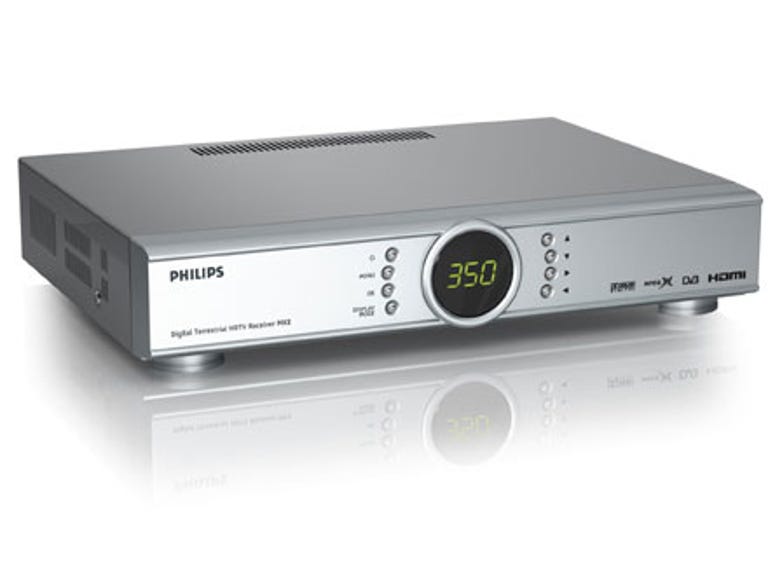 Why You Can Trust CNET
Why You Can Trust CNET Philips DTR7200 review: Philips DTR7200
Philips' DTR7200 HD Set Top Box is a very good choice for standard definition viewing. If only there was some worthwhile HD content out there to watch on it...
Design
The most striking aspect of the Philips DTR7200's visual display is the round LED display that sits dead in the centre of the front panel; it's used for channel ID, time and even displaying the current output resolution. It's encircled with function buttons that control basic menu functions and allow you to quickly and simply switch output resolution. Aside from a few company logos, the rest of the DTR7200's front panel is left starkly bare, which gives the design a very nice sleek feel. Sure, it still does look like any other TV component you'd care to name for the most part, but it at least isn't an ugly TV component, unlike many other set top boxes.
The Good
The Bad
The Bottom Line
The rear of the DTR7200 houses the connecting inputs and outputs, as you'd expect; a single antennae in sits above the coaxial video out -- although why you'd use coaxial on a high definition set top box totally eludes us. Otherwise, you've got a single HDMI output, component, S-video and composite connectors, along with a serial port for applying firmware upgrades. Audio output is via either optical, S/PDIF or plain old RCA stereo cables.
The DTR7200's remote is quite busy, but then it's designed to run other Philips AV equipment; there are even buttons at the very bottom of the remote that control the Ambilight features found on certain Philips display panels. Its busy nature contrasts quite sharply against the minimalist display lines of the front panel, although again, there are few remotes on the market that we'd expressly call "attractive".
Features
The DTR7200 is a digital set top box capable of receiving standard and high definition free to air broadcasts and displaying them at either 576p, 720p or 1080i, depending on the capabilities of the output panel it's connected to. It features a seven day EPG function -- more on that below -- and the ability to zoom in on 4:3 broadcasts in order to eliminate side-letterboxing.
The DTR7200 also features what Philips calls "Pulse Killer" technology. Philips claims that the inclusion of its Pulse Killer Chip eliminates interference from other electrical sources, leading to best possible picture reception.
Performance
We tested the DTR7200 with a Philips 32PF9830 LCD TV in the Sydney metropolitan area. Picture quality was superb on standard and high definition sources, and we were particularly impressed with the ability to switch output resolution modes quickly and painlessly to match the quality of the incoming source. It's tough to assess the effectiveness of the Pulse Killer technology, as you'd essentially need a "dirty" signal for it to clean up, but we can see the potential application of it. Anecdotal evidence (including the Government's own white paper on the subject) suggests that many Australian consumers have made the switch to digital more for matters of improved reception than anything else, so any technology that helps improve that should, in theory, be a good thing.
We were particularly impressed with the DTR7200's menu structures, which are incredibly easy to follow and have clear and logical paths for setting all of the box functions. The same is true of the EPG display, which has a clean and easy to read multi-channel interface, but it's almost totally wasted in the Australian market for one very simple reason that isn't the DTR7200's fault. None of the current digital broadcasters actually transmit their full EPG schedules seven days in advance, so you essentially end up looking at a rather blank screen beyond the current and next program. There's no USB input on the DTR7200, so you couldn't even integrate a commercial EPG such as ICEGuide, either.
Philips claim that the remote that ships with the DTR7200 is compatible with other Philips AV equipment including amps and HD TV displays, including distinct buttons for controlling Philips Ambilight panels. We tested with a variety of Philips equipment including the aforementioned 32PF9830, and had mixed experiences. As an example, the remote had no problems controlling the Ambilight features of the TV, but struggled for some reason to control the volume.
There's a more pressing problem with the DTR7200, however. It's no fault of the technology itself, but at the current time there's precious little HD content actually being broadcast at the moment -- especially if you're not a big fan of American legal dramas or, say, Kerri-Anne. This makes any HD STB, including the DTR7200 a tough proposition. On the one hand, it may be something of a future-proofing investment for if HD digital broadcasts do become more common. On the other hand, if that does occur, you can expect consumer interest in HD STBs, and the prices of such equipment, to drop substantially.


